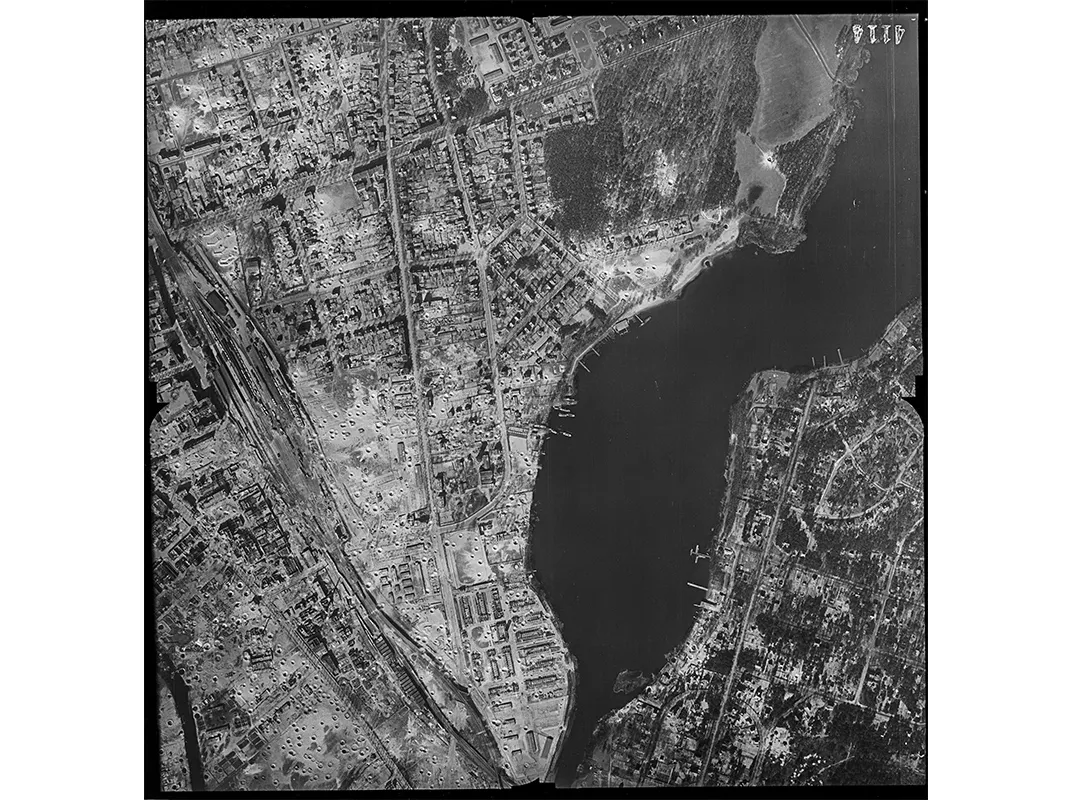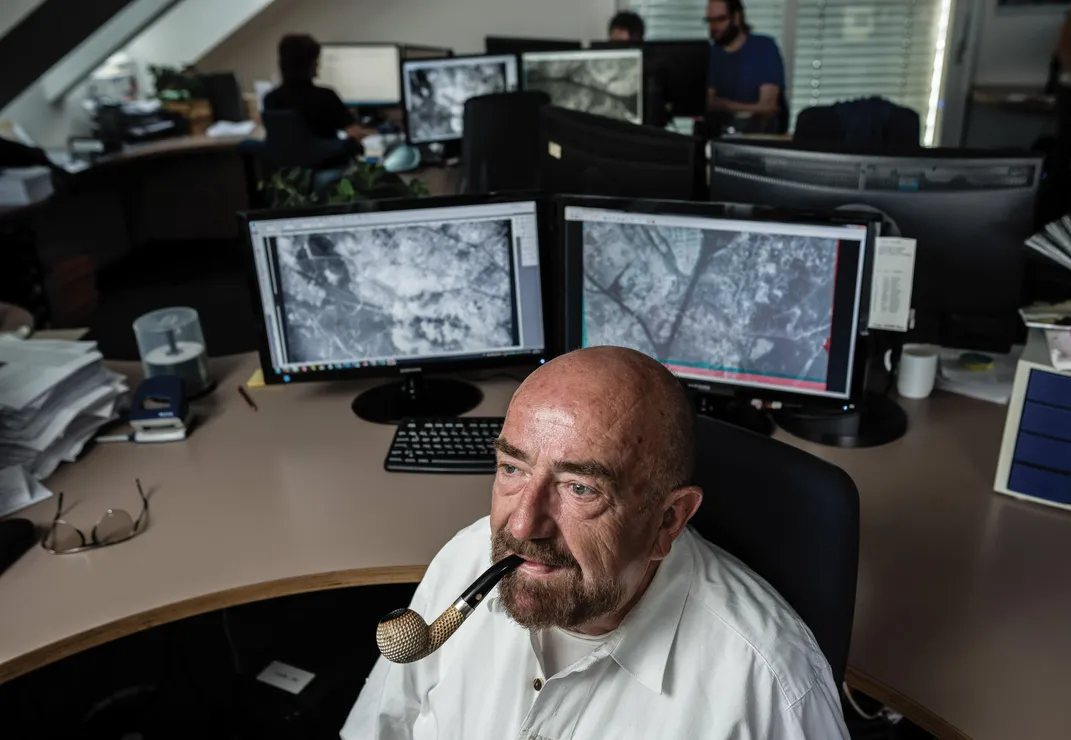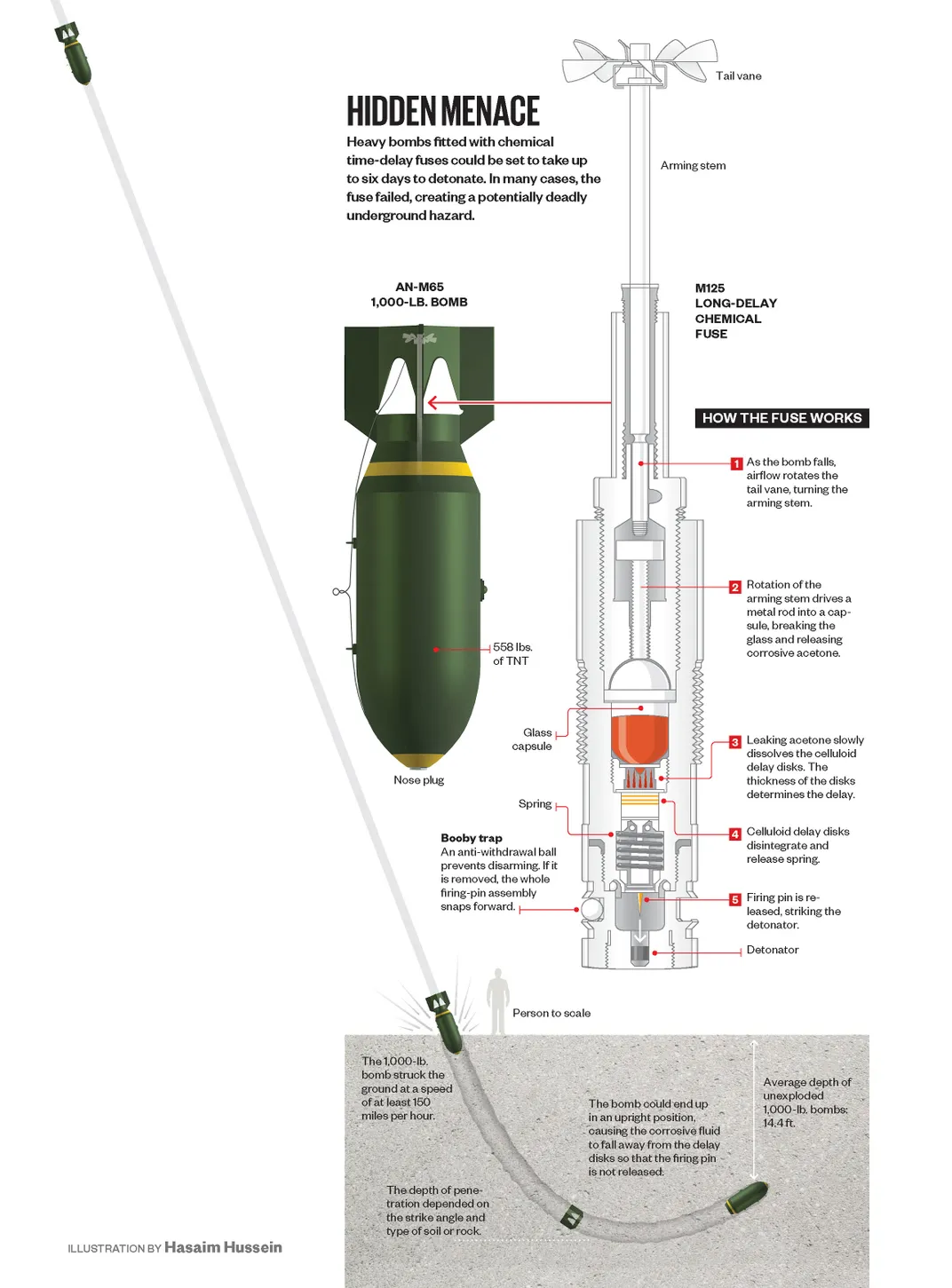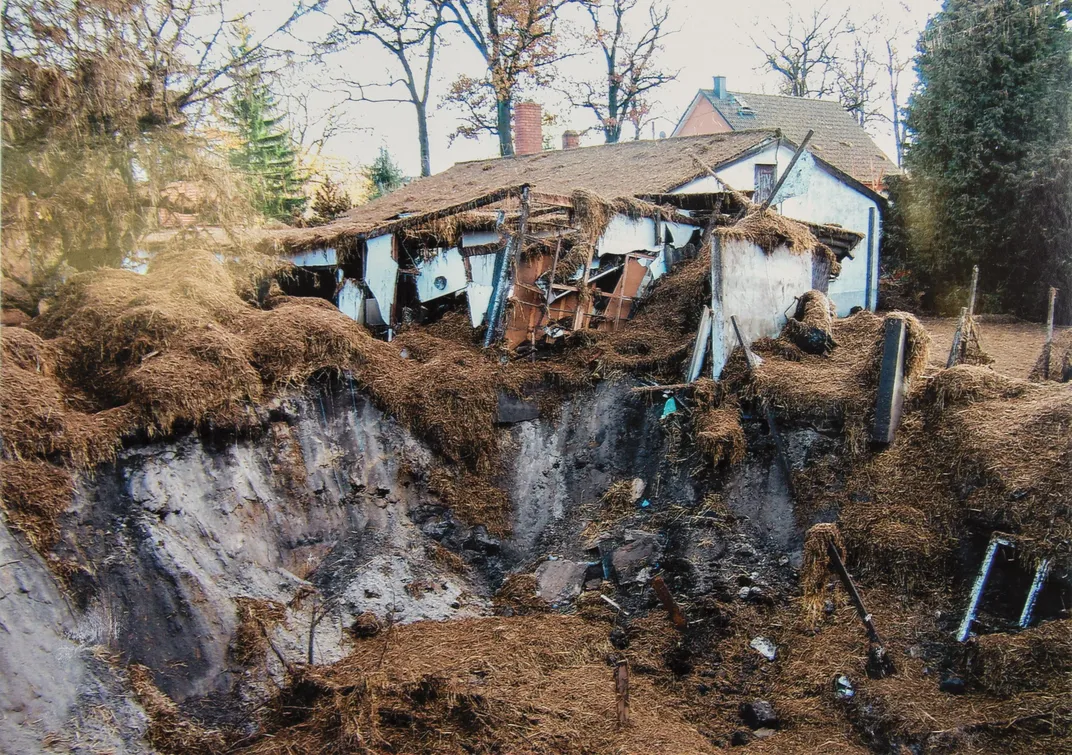There Are Still Thousands of Tons of Unexploded Bombs in Germany, Left Over From World War II
More than 70 years after being dropped in Europe, the ordnance is still inflicting harm and mayhem
/https://tf-cmsv2-smithsonianmag-media.s3.amazonaws.com/filer/1d/b8/1db82154-0dfa-41cf-809e-d19a0d4e0ae9/janfeb2016_e01_bombs.jpg)
Shortly before 11 a.m. on March 15, 1945, the first of 36 B-17 Flying Fortresses of the 493rd Bombardment Group of the U.S. Eighth Air Force thundered down the concrete runway of Little Walden airfield in Essex, England, and rose slowly into the air. They headed east, gradually gaining altitude until, assembled in tight box formations at the head of a stream of more than 1,300 heavy bombers, they crossed the Channel coast north of Amsterdam at an altitude of almost five miles. Inside the unpressurized aluminum fuselage of each aircraft, the temperature fell to 40 degrees below zero, the air too thin to breathe. They flew on into Germany, passing Hanover and Magdeburg, the exhaust of each B-17’s four engines condensing into the white contrails every crewman hated for betraying their position to defenders below. But the Luftwaffe was on its knees; no enemy aircraft engaged the bombers of the 493rd.
Around 2:40 p.m., some ten miles northwest of Berlin, the city of Oranienburg appeared beneath them, shrouded in a mist along the lazy curves of Havel River, and the sky blossomed with puffs of jet-black smoke from anti-aircraft fire. Sitting in the nose in the lead plane, the bombardier stared through his bombsight into the haze far below. As his B-17 approached the Oder-Havel Canal, he watched as the needles of the automatic release mechanism converged. Five bombs tumbled away into the icy sky.
**********
Between 1940 and 1945, U.S. and British air forces dropped 2.7 million tons of bombs on Europe, half of that amount on Germany. By the time the Nazi government surrendered, in May 1945, the industrial infrastructure of the Third Reich—railheads, arms factories and oil refineries—had been crippled, and dozens of cities across Germany had been reduced to moonscapes of cinder and ash.
Under Allied occupation, reconstruction began almost immediately. Yet as many as 10 percent of the bombs dropped by Allied aircraft had failed to explode, and as East and West Germany rose from the ruins of the Reich, thousands of tons of unexploded airborne ordnance lay beneath them. In both East and West, responsibility for defusing these bombs—along with removing the innumerable hand grenades, bullets and mortar and artillery shells left behind at the end of the war—fell to police bomb-disposal technicians and firefighters, the Kampfmittelbeseitigungsdienst, or KMBD.
Even now, 70 years later, more than 2,000 tons of unexploded munitions are uncovered on German soil every year. Before any construction project begins in Germany, from the extension of a home to track-laying by the national railroad authority, the ground must be certified as cleared of unexploded ordnance. Still, last May, some 20,000 people were cleared from an area of Cologne while authorities removed a one-ton bomb that had been discovered during construction work. In November 2013, another 20,000 people in Dortmund were evacuated while experts defused a 4,000-pound “Blockbuster” bomb that could destroy most of a city block. In 2011, 45,000 people—the largest evacuation in Germany since World War II—were forced to leave their homes when a drought revealed a similar device lying on the bed of the Rhine in the middle of Koblenz. Although the country has been at peace for three generations, German bomb-disposal squads are among the busiest in the world. Eleven bomb technicians have been killed in Germany since 2000, including three who died in a single explosion while trying to defuse a 1,000-pound bomb on the site of a popular flea market in Göttingen in 2010.
Early one recent winter morning, Horst Reinhardt, chief of the Brandenburg state KMBD, told me that when he started in bomb disposal in 1986, he never believed he would still be at it almost 30 years later. Yet his men discover more than 500 tons of unexploded munitions every year and defuse an aerial bomb every two weeks or so. “People simply don’t know that there’s still that many bombs under the ground,” he said.
And in one city in his district, the events of 70 years ago have ensured that unexploded bombs remain a daily menace. The place looks ordinary enough: a drab main street, pastel-painted apartment houses, an orderly railway station and a McDonald’s with a tubular thicket of bicycles parked outside. Yet, according to Reinhardt, Oranienburg is the most dangerous city in Germany.

**********
Between 2:51 and 3:36 p.m. on March 15, 1945, more than 600 aircraft of the Eighth Air Force dropped 1,500 tons of high explosives over Oranienburg, a cluster of strategic targets including rail yards that were a hub for troops headed to the Eastern Front, a Heinkel aircraft plant and, straddling the rail yards, two factories run by the chemical conglomerate Auergesellschaft. Allied target lists had described one of those facilities as a gas-mask factory, but by early 1945 U.S. intelligence had learned that Auergesellschaft had begun processing enriched uranium, the raw material for the atomic bomb, in Oranienburg.
Although the March 15 attack was ostensibly aimed at the rail yards, it had been personally requested by the director of the Manhattan Project, Gen. Leslie Groves, who was determined to keep Nazi nuclear research out of the hands of rapidly advancing Russian troops. Of the 13 Allied air attacks eventually launched on the city, this one, the fourth within a year, was by far the heaviest and most destructive.
As one squadron of B-17s followed another into its run, almost five thousand 500- and 1,000-pound bombs and more than 700 incendiaries fell across the rail yards, the chemical factory and into the residential streets nearby. The first explosions started fires around the railroad station; by the time the final B-17s began their attack, smoke from the burning city was so heavy the bombardiers had difficulty seeing where their bombs were falling. But where it cleared, the men of the First Air Division watched three concentrations of high explosives fall into houses near the road over the Lehnitzstrasse canal bridge, around a mile southeast of the rail station and a few hundred yards from one of the chemical factories.
These bomb loads were unlike almost any others the Eighth Air Force dropped over Germany during the war. The majority of the bombs were armed not with percussion fuses, which explode on impact, but with time-delay fuses, which both sides used throughout the war in order to extend the terror and chaos caused by aerial attacks. The sophisticated, chemical-based fuses—designated M124 and M125, depending on the weight of the bomb—were intended to be used sparingly; U.S. Army Air Force guidelines recommended fitting them in no more than 10 percent of bombs in any given attack. But for reasons that have never become clear, almost every bomb dropped during the March 15 raid on Oranienburg was armed with one.
Screwed into a bomb’s tail beneath its stabilizing fins, the fuse contained a small glass capsule of corrosive acetone mounted above a stack of paper-thin celluloid disks less than half an inch in diameter. The disks held back a spring-loaded firing pin, cocked behind a detonator. As the bomb fell, it tilted nose-down, and a windmill in the tail stabilizer began spinning in the slipstream, turning a crank that broke the glass capsule. The bomb was designed to hit the ground nose-down, so the acetone would drip toward the disks and begin eating through them. This could take minutes or days, depending on the concentration of acetone and the number of disks the armorers had fitted into the fuse. When the last disk weakened and snapped, the spring was released, the firing pin struck the priming charge and—finally, unexpectedly—the bomb exploded.

Around three o’clock that afternoon, a B-17 from the Eighth Air Force released a 1,000-pound bomb some 20,000 feet above the rail yards. Quickly reaching terminal velocity, it fell toward the southwest, missing the yards and the chemical plants. It fell instead toward the canal and the two bridges connecting Oranienburg and the suburb of Lehnitz, closing on a wedge of low-lying land framed by the embankments of Lehnitzstrasse and the railroad line. Before the war this had been a quiet spot beside the water, leading to four villas among the trees, parallel to a canal on Baumschulenweg. But now it was occupied by anti-aircraft guns and a pair of narrow, wooden, single-story barracks built by the Wehrmacht. This was where the bomb finally found the earth—just missing the more westerly of the two barracks and plunging into the sandy soil at more than 150 miles per hour. It bored down at an oblique angle before the violence of its passage tore the stabilizing fins away from the tail, when it abruptly angled upward until, its kinetic energy finally spent, the bomb and its M125 fuse came to rest: nose-up but still deep underground.
By four o’clock, the skies over Oranienburg had fallen silent. The city center was ablaze, the first of the delayed explosions had started: The Auergesellschaft plant would soon be destroyed and the rail yards tangled with wreckage. But the bomb beside the canal lay undisturbed. As the shadows of the trees on Lehnitzstrasse lengthened in the low winter sun, acetone dripped slowly from the shattered glass capsule within the bomb’s fuse. Taken by gravity, it trickled harmlessly downward, away from the celluloid disks it was supposed to weaken.
Less than two months later, Nazi leaders capitulated. As much as ten square miles of Berlin had been reduced to rubble. In the months following V-E Day that May, a woman who had been bombed out of her home there found her way, with her young son, out to Oranienburg, where she had a boyfriend. The town was a constellation of yawning craters and gutted factories, but beside Lehnitzstrasse and not far from the canal, she found a small wooden barracks empty and intact. She moved in with her boyfriend and her son.
**********
Abandoned ammunition and unexploded bombs claimed their first postwar victims almost as soon as the last guns fell silent. In June 1945, a cache of German anti-tank weapons exploded in Bremen, killing 35 and injuring 50; three months later in Hamburg, a buried American 500-pound bomb with a time-delay fuse took the lives of the four technicians working to disarm it. Clearing unexploded munitions became the task of the German states’ KMBD. It was dangerous work done at close quarters, removing fuses with wrenches and hammers. “You need a clear head. And calm hands,” Horst Reinhardt told me. He said he never felt fear during the defusing process. “If you’re afraid, you can’t do it. For us, it’s a completely normal job. In the same way that a baker bakes bread, we defuse bombs.”
In the decades after the war, bombs, mines, grenades and artillery shells killed dozens of KMBD technicians and hundreds of civilians. Thousands of unexploded Allied bombs were excavated and defused. But many had been buried in rubble or simply entombed in concrete during wartime remediation and forgotten. In the postwar rush for reconstruction, nobody kept consistent information about where unexploded bombs had been made safe and removed. A systematic approach to finding them was officially regarded as impossible. When Reinhardt started work with the East German KMBD in 1986, both he and his counterparts in the West usually found bombs the same way: one at a time, often during construction work.
But the government of Hamburg had recently brokered an agreement to allow the states of West Germany access to the 5.5 million aerial photographs in the declassified wartime archives of the Allied Central Interpretation Unit, held in Keele in England. Between 1940 and 1945, ACIU pilots flew thousands of reconnaissance missions before and after every raid by Allied bombers, taking millions of stereoscopic photographs that revealed both where the attacks could be directed and then how successful they had proved. Those images held clues to where bombs had landed but never detonated—a small, circular hole, for example, in an otherwise consistent line of ragged craters.
Around the same time, Hans-Georg Carls, a geographer working on a municipal project using aerial photography to map trees in Würzburg, in southern Germany, stumbled on another trove of ACIU images. Stored in a teacher’s cellar in Mainz, they had been ordered from the archives of the U.S. Defense Intelligence Agency by an enterprising American intelligence officer based in Germany, who had hoped to sell them privately to the German government for his own profit. When he failed, he sold 60,000 of them to the teacher for a few pfennigs each. Carls, sensing a business opportunity, snapped them up for a deutsche mark apiece.

When he compared what he’d bought with what the German government had copied from the British, he realized he had images the British didn’t. Convinced there must be more, held somewhere in the United States, Carls established a company, Luftbilddatenbank. With the help of archivists in Britain and the States, he brought to light hundreds of cans of aerial reconnaissance film that had gone unexamined for decades. Crucially, Carls also found the maps made by the pilots who shot the film—“sortie plots” showing exactly where each run of pictures had been taken—which had often been archived elsewhere, and without which the images would be meaningless.
Supplementing the photographs and the sortie plots with local histories and police records, contemporary eyewitness testimony and the detailed records of bombing missions held at the Air Force Historical Research Agency at Maxwell Air Force Base in Alabama, Carls was able to build a chronology of everything that had happened to a given patch of land between 1939 and 1945. Examining the photographs using a stereoscope, which makes the images appear in 3-D, Carls could see where bombs had fallen, where they had exploded and where they may not have. From that data he could compile an Ergebniskarte—a “result map”—for clients ranging from international consortiums to homeowners, with high-risk areas crosshatched in red. “He was the pioneer,” said Allan Williams, curator of Britain’s National Collection of Aerial Photography, which now includes the pictures once held in Keele.
Carls, now nearing 68 and semi-retired, employs a staff of more than 20, with offices occupying the top three floors of his large house in a suburb of Würzburg. Image analysis is now a central component of bomb disposal in each of Germany’s 16 states, and Carls has provided many of the photographs they use, including all of those used by Reinhardt and the Brandenburg KMBD.
One day in the Luftbilddatenbank office, Johannes Kroeckel, 37, one of Carls’ senior photo-interpreters, called up a Google Earth satellite image of the area north of Berlin on one of two giant computer monitors on his desk. He closed in on an L-shaped cul-de-sac in Oranienburg, in the area between Lehnitzstrasse and the canal. On the other monitor, he used the geolocation data of the address to summon a list of more than 200 aerial photographs of the area shot by Allied reconnaissance pilots and scrolled through them until he found the ones he needed. A week after the March 15 raid, photographs 4113 and 4114 were taken from 27,000 feet over Oranienburg, a fraction of a second apart. They showed the scene near the canal in sharp monochromatic detail, the curve of the Lehnitzstrasse bridge and the bare branches of the trees on Baumschulenweg tracing fine shadows on the water and the pale ground beyond. Then Kroeckel used Photoshop to tint one picture in cyan and the other in magenta, and combined them into a single image. I put on a pair of cardboard 3-D glasses, and the landscape rose toward me: upended matchbox shapes of roofless houses; a chunk of earth bitten out of the Lehnitzstrasse embankment; a giant, perfectly circular crater in the middle of Baumschulenweg.
Yet we could see no sign of a dormant 1,000-bomb concealed in the ruins of the neighborhood, where, soon after the photograph was taken, a woman would find a home for herself and her family. Kroeckel explained that even an image as stark as this one could not reveal everything about the landscape below. “Maybe you have shadows of trees or houses,” he said, pointing to a crisp quadrilateral of late-winter shade cast by one of the villas a few hundred yards from the canal. “You can’t see every unexploded bomb with the aerials.” But there was more than enough evidence to mark an Ergebniskarte in ominous red ink.
**********
Paule Dietrich bought the house on the cul-de-sac in Oranienburg in 1993. He and the German Democratic Republic had been born on the same day, October 7, 1949, and for a while the coincidence seemed auspicious. When he turned 10, he and a dozen or so other children who shared the birthday were taken to tea with President Wilhelm Pieck, who gave them each passbooks to savings accounts containing 15 Ostmarks. At 20, he and the others were guests at the opening of the Berlin TV tower, the tallest building in all of Germany. Over the next 20 years, the Republic was good to Dietrich. He drove buses and subway trains for the Berlin transit authority. He was given an apartment in the city, and he became a taxi driver. He added to the savings the president had given him, and on an abandoned piece of land in Falkensee, in the countryside outside the city, he built a summer bungalow.
But in 1989, Dietrich turned 40, the Berlin Wall fell and his Ostmarks became worthless overnight. Three years later, the rightful owners of the land in Falkensee returned from the West to reclaim it.
In nearby Oranienburg, where his mother had lived since the 1960s, Dietrich met an elderly lady who was trying to sell a small wooden house down by the canal—an old Wehrmacht barracks she’d lived in since the war. It needed a lot of work, but it was right by the water. Dietrich sold his car and mobile home to buy it and began working on it whenever he could. His girlfriend and Willi, their only son, joined him, and slowly the house came together. By 2005, it was finished—plastered, weatherproofed and insulated, with a garage, a new bathroom and a brick fireplace. Dietrich began living there full-time from May to December and planned to move in permanently when he retired.
Like everyone else in Oranienburg, he knew the city had been bombed during the war, but so had a lot of places in Germany. And parts of Oranienburg were evacuated so frequently that it was easy to believe there couldn’t be many bombs left. Buried bombs had apparently gone off on their own a few times—once, just around the corner from Dietrich’s house, one exploded under the sidewalk where a man was walking his dog. But nobody, not even the dog and its walker, had been seriously injured. Most people simply preferred not to think about it.
The state of Brandenburg, however, knew Oranienburg presented a unique problem. Between 1996 and 2007, the local government spent €45 million on bomb disposal—more than any other town in Germany, and more than a third of total statewide expenses for unexploded ordnance during that time. In 2006, the state Ministry of the Interior commissioned Wolfgang Spyra of the Brandenburg University of Technology to determine how many unexploded bombs might remain in the city and where they might be. Two years later, Spyra delivered a 250-page report revealing not only the huge number of time bombs dropped on the city on March 15, 1945, but also the unusually high proportion of them that had failed to go off. That was a function of local geology and the angle at which some bombs hit the ground: Hundreds of them had plunged nose-first into the sandy soil but then had come to rest nose-up, disabling their chemical fuses. Spyra calculated that 326 bombs—or 57 tons of high-explosive ordnance—remained hidden beneath the city’s streets and yards.
And the celluloid disks in the bombs’ timing mechanisms had become brittle with age and acutely sensitive to vibration and shock. So bombs had begun to go off spontaneously. A decayed fuse of this type was responsible for the deaths of the three KMBD technicians in Göttingen in 2010. They had dug out the bomb, but weren’t touching it when it went off.

**********
In January 2013, Paule Dietrich read in the newspaper that the city of Oranienburg was going to start looking for bombs in his neighborhood. He had to fill out some forms, and in July, city contractors arrived. They drilled 38 holes in his yard, each more than 30 feet deep, and dropped a magnetometer into every one. It took two weeks. A month later, they drilled more holes in back of the house. They were zeroing in on something, but didn’t say what.
It was nine in the morning on October 7, 2013—the day Dietrich turned 64—when a delegation of city officials arrived at his front gate. “I thought they were here for my birthday,” he said when I met him recently. But that wasn’t it at all. “There’s something here,” the officials told him. “We need to get at it.” They said that it was ein Verdachtspunkt—a point of suspicion. Nobody used the word “bomb.”
They marked the spot beside the house with an orange traffic cone and prepared to pump out groundwater from around it. When Dietrich’s friends turned up that afternoon to celebrate his birthday, they took pictures of the cone. Throughout October, the contractors had pumps running round the clock. They started digging at seven every morning and stayed until eight every night. Each morning they drank coffee in Dietrich’s carport. “Paule,” they said, “this will be no problem.”
It took them another month to uncover the bomb, more than 12 feet down: 1,000 pounds, big as a man, rusted, its tail stabilizer gone. They shored up the hole with steel plates and chained the bomb so it couldn’t move. Every night, Dietrich stayed in the house with his German shepherd, Rocky. They slept with their heads just a few feet from the hole. “I thought everything was going to be fine,” he said.
On November 19, the contractors were drinking coffee as usual when their boss arrived. “Paule, you need to take your dog and get off the property immediately,” he said. “We have to create an exclusion zone right now, all the way from here to the street.”
Dietrich took his TV set and his dog and drove over to his girlfriend’s house, in Lehnitz. On the radio, he heard that the city had stopped the trains running over the canal. The KMBD was defusing a bomb. The streets around the house were sealed off. Two days later, on Saturday morning, he heard on the news that the KMBD said the bomb couldn’t be defused; it would have to be detonated. He was walking with Rocky in the forest a mile away when he heard the explosion.
Two hours later, when the all-clear siren sounded, Dietrich drove over to his place with a friend and his son. He could barely speak. Where his house had once stood was a crater more than 60 feet across, filled with water and scorched debris. The straw the KMBD had used to contain bomb splinters was scattered everywhere—on the roof of his shed, across his neighbor’s yard. The wreckage of Dietrich’s front porch leaned precariously at the edge of the crater. The mayor, a TV crew and Horst Reinhardt of the KMBD were there. Dietrich wiped away tears. He was less than a year from retirement.

**********
Early one morning at the headquarters of the Brandenburg KMBD in Zossen, Reinhardt swept his hand slowly across a display case in his spartan, linoleum-floored office. “These are all American fuses. These are Russian ones, these are English ones. These are German ones,” he said, pausing among the dozens of metal cylinders that filled the case, some topped with small propellers, others cut away to reveal the mechanisms inside. “These are bomb fuses. These are mine fuses. That’s just a tiny fingernail of what’s out there.”
At 63, Reinhardt was in the last few days of his career in bomb disposal and looking forward to gardening, collecting stamps and playing with his grandchildren. He recalled the bomb in Paule Dietrich’s yard, and said his men had had no alternative but to blow it up. Sallow and world-weary, he said it was impossible to tell how long it would take to clear Germany of unexploded ordnance. “There will still be bombs 200 years from now,” he told me. “It’s becoming increasingly difficult. At this point, we’ve dealt with all the open spaces. But now it’s the houses, the factories. We have to look directly underneath the houses.”
Late the following day, as the wet wind slapped viciously at the plastic roof overhead, I sat with Paule Dietrich in what had been his carport. A few feet of grass separated it from the spot where his house once stood. The bomb crater had been filled in, and Dietrich was living there in a mobile home. He kept the carport for entertaining, and had equipped it with a fridge, a shower and furniture donated by friends and supporters from Oranienburg, where he has become a minor celebrity.

Sitting at a small table, Dietrich chain-smoked Chesterfields and drank instant coffee. He produced an orange binder filled with photographs of his former home: as it was when he bought it; when he and his colleagues were decorating it; and, finally, as it was after the bomb had reached the end of its 70-year fuse. Dietrich said he realized that he and his family had been lucky: Every summer, his grandchildren had played in a plastic pool near where the bomb had been lying; at night, they slept in a mobile home beside the pool. “Directly on the bomb,” he said.
By the time we met, Dietrich had been offered scant financial compensation by the authorities—technically, the federal government was required to pay only for damage caused by German-made munitions. But among a pile of documents and newspaper clippings he had in the binder was a rendering of the new home he wanted to build on the site. It had once been the best prefabricated bungalow available in East Germany, he said, and a contractor in Falkensee had given him all the components of one, except for the roof. Even so, more than a year after the explosion, he hadn’t started work on it.
Outside, in the afternoon gloaming, he showed me why. In the grass at the bottom of the embankment of Lehnitzstrasse was a patch of sandy ground. Men from the city had recently marked it with two painted stakes. They had told him only that it was a “double anomaly,” but he knew precisely what they meant. Paule Dietrich had two more unexploded American bombs at the end of his yard.
Related Reads

Bombs Away